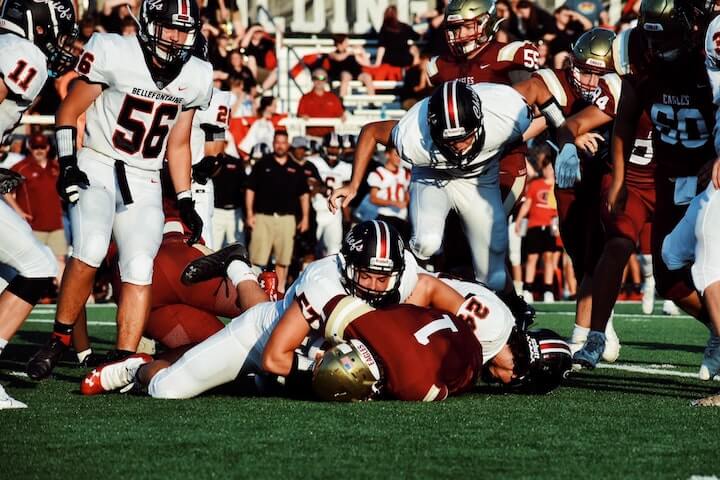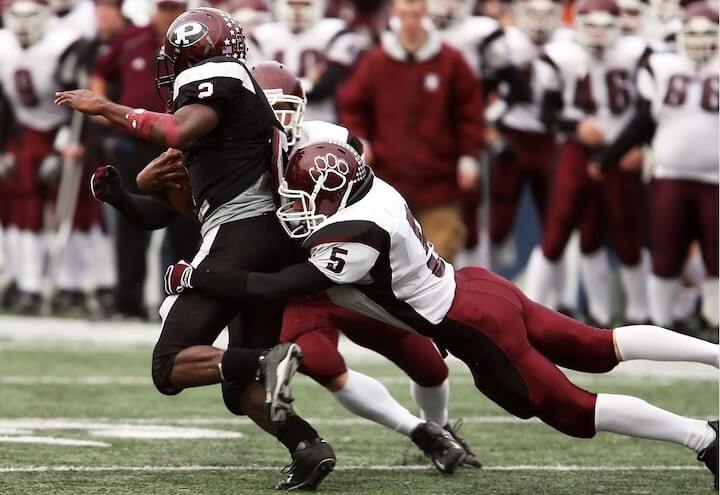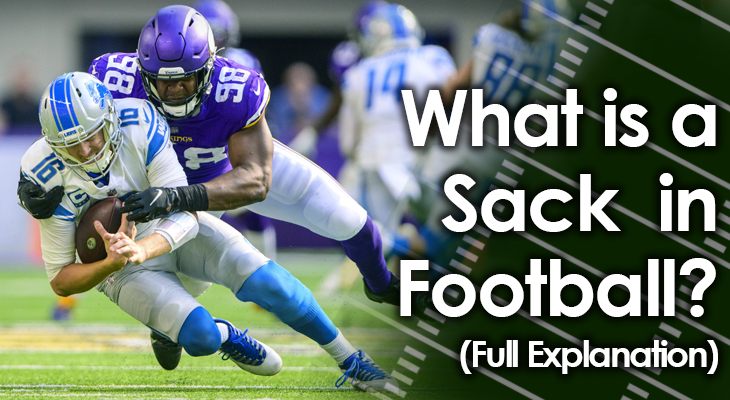A sack is one of the most exciting plays in football for the defense.
(And one of the most disappointing for the offense)
When the defense records a sack, they push the offense back, putting them in a difficult position to make a first down and keep the chains moving.
Sacks can completely change the momentum of a football game.
Just when the offense was looking like they were aiming for a big play in the passing game, in comes a defender to turn that all around.
With one hit, a sack can dampen the offense's spirits while lifting up everyone on the defensive side of the ball -- as well as all their fans.
But, what exactly is a sack?
What happens when a sack is recorded?
And how can you successfully record a sack?
Let's take a look at all of these angles of a sack below.
What is a Sack in Football?
A sack occurs when a defensive player tackles the quarterback behind the line of scrimmage as he's dropping back to pass.
Any member of the defense can record a sack, though there are certain positions that are more likely to rack up high sack totals in any given season.
Pass-rushing specialist positions such as defensive ends and outside linebackers are the two positions that will usually record the most sacks.
However, there are interior defensive linemen that rush the passer really well.
Even cornerbacks, safeties, and middle linebackers can get in on the action during blitzes.
When the quarterback drops back to pass, he'll scan the field looking for an open receiver.
As he does this, defenders will try to break through the blocks of the offensive line and get to the quarterback before he's able to release the ball.
As the quarterback is searching for a player to pass to, he is a considered a ball carrier. Meaning any defender has the right to tackle him and take him down to the ground.
When this happens behind the line of scrimmage, it's called a sack.

What Happens When a Sack is Recorded?
Sacks are official statistics kept and recorded by most football leagues.
Players either get credit for a full sack or a half sack...
Full sack = they make the tackle on their own.
Half sack = they tackle in combination with another defender.
A sack isn't a special play that the referee gets involved in like a penalty.
Instead, it's just an offensive play that results in a loss of yardage -- like if a running back gets tackled behind the line of scrimmage after a handoff.
The referee will then place the ball at the spot where the sack occurred and the next down will begin at that spot.
An example:
If the play begins with the offense in a first-and-10 situation and the quarterback gets sacked for a loss of 7 yards, the next play will be second-and-17 from the spot at which the quarterback got sacked.
One difference between a sack and another play that results in a loss of yardage:
The play clock won't begin following a sack until the quarterback gets off the ground, the ball is spotted, and a few seconds tick off.
In other words, the referee will give the quarterback a few seconds to gather himself before the play clock starts for the succeeding play.
This gives the offense a fair amount of time to regroup and get back in the huddle, since many of the receivers may be far downfield.
How to Make a Sack
When the ball is snapped on a passing play, certain players will have only one job:
Get to the QB as quickly as possible and try to disrupt his passing attempt.
On almost all passing plays, all defensive linemen -- both tackles and ends -- will be singularly focused on trying to record a sack.
Read Next: 5 Defensive Line Drills to Get More Sacks and Tackles
To do this, they will use different tactics to try and get by the offensive linemen whose job it is to protect the quarterback from rushing defenders.
The defenders may try a swim move, a 360-spin, and even a bull rush to try to trick and/or overpower their assigned blocker.
The defensive coach may also call different schemes to give his players the best chance possible.
This may include stunt rushes with a combination of two players along the line of scrimmage. It also frequently involves blitzes -- where additional defenders rush the quarterback.
Sometimes, successful sacks occur due to a number's game, where the defense rushes more players than the offense has staying in to block.
No matter what maneuvers and tactics, one of the biggest factors for successfully recording a sack is how quickly defenders get off the ball.
Defenders need to try to master the art of timing the snap to be able to rush almost immediately and get a leg up on the offense.

Conclusion
A sack is one of the most exciting plays in all of football.
It's a statistic that defenders are always trying to rack up, not just for their personal accomplishments, but because a sack can completely change a game around.
Sacks are something every defensive coach loves to see, and every offensive coach despises.

